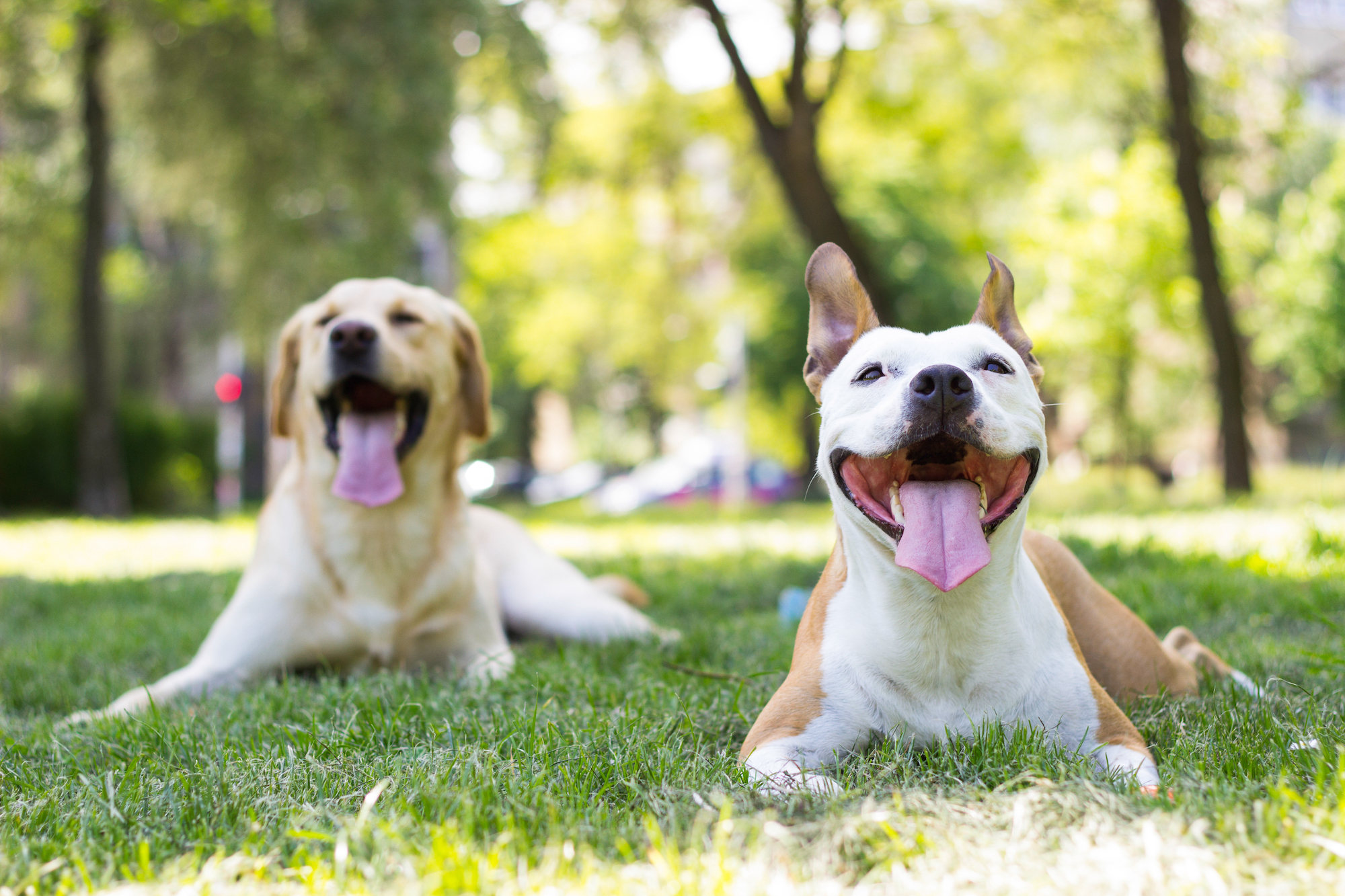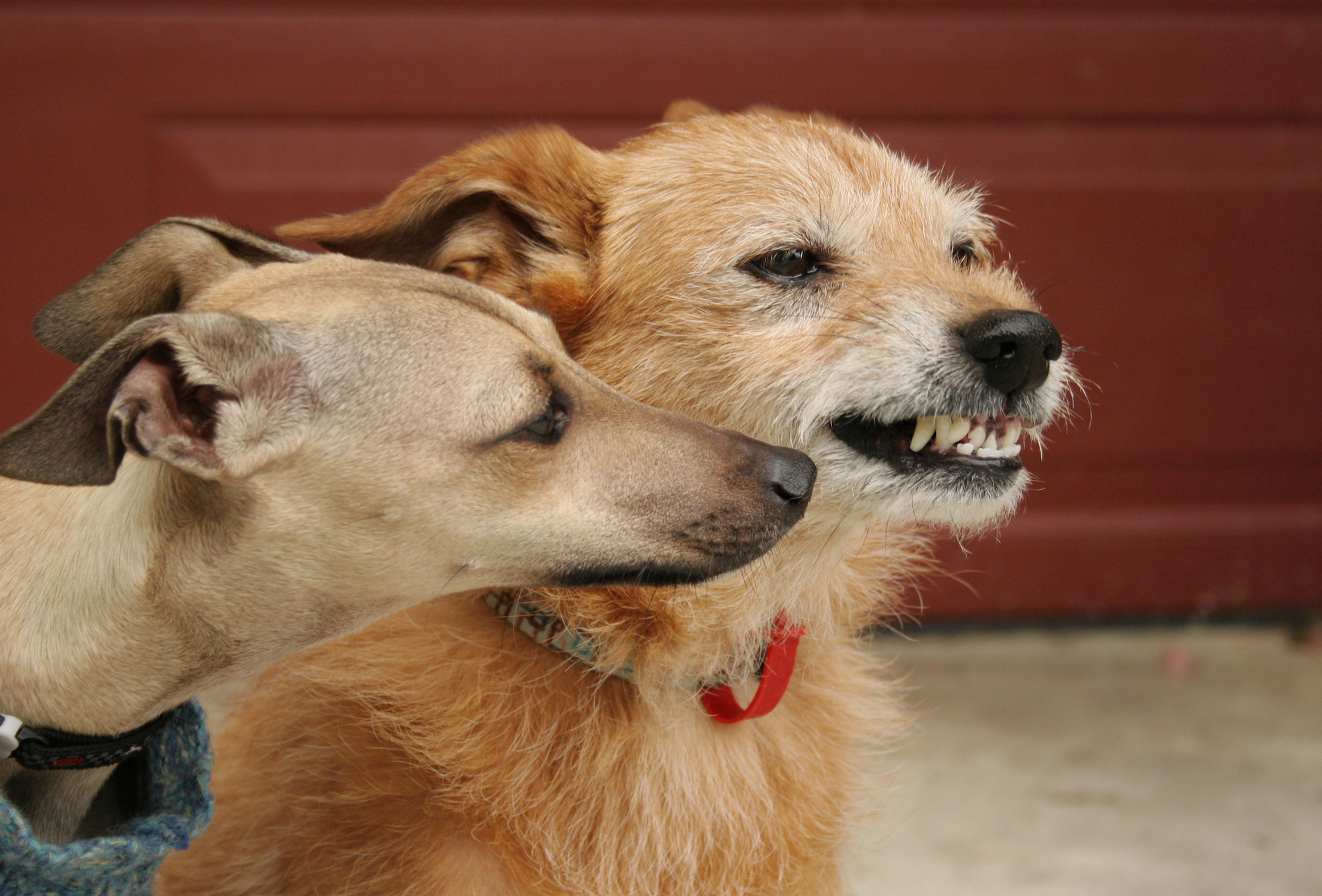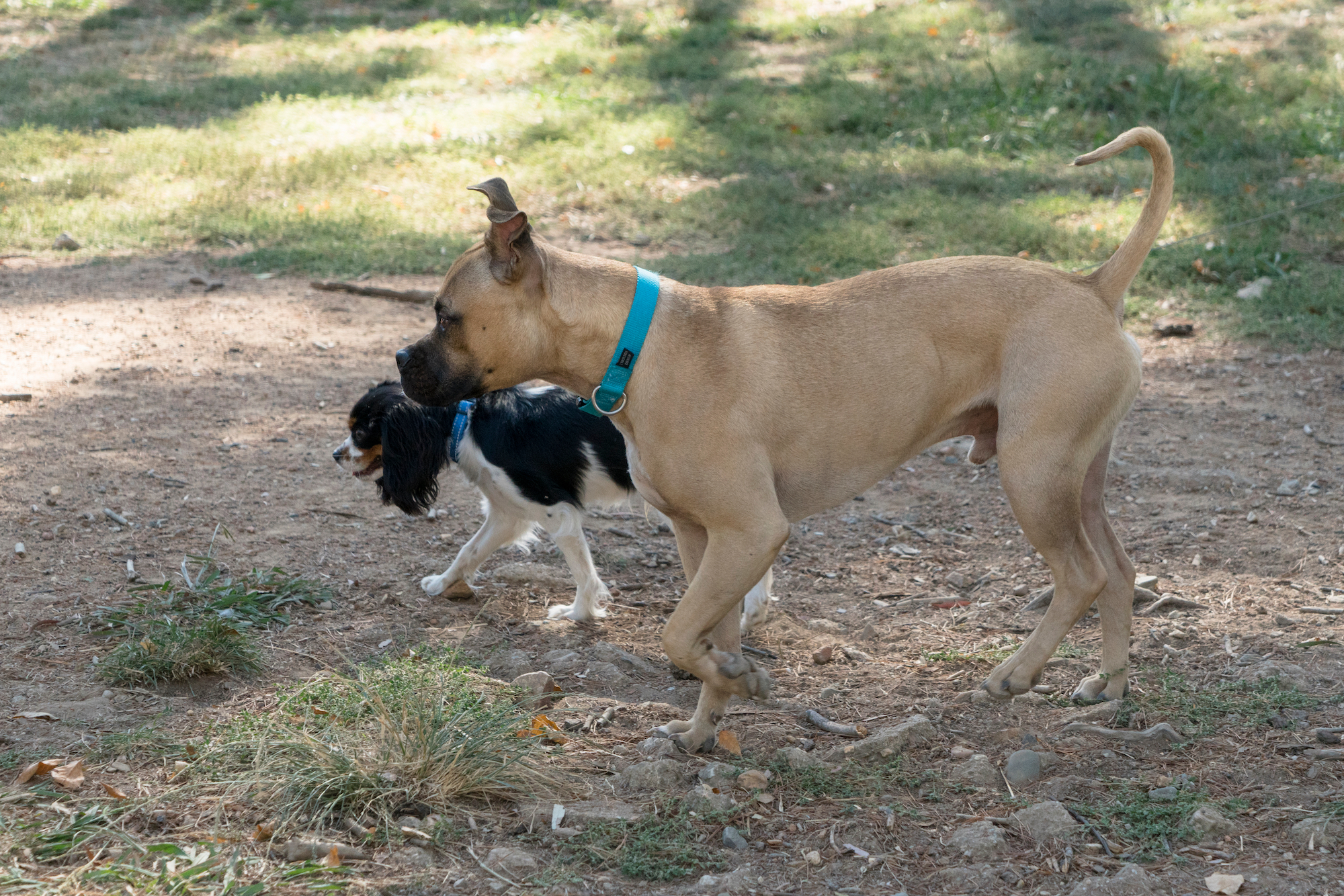You already have one dog, and they seem content. You’re giving them the care and training they need. Is it prudent to get another one?
A voice in your head may say: “If one dog is good, two must be better.” But, while adding a second pup to your family can be a great idea, there is more to it than that. Your decision will depend on why you want another dog, and how that choice will impact the other humans and animals in your home.
Dr. Marc Bekoff, Professor Emeritus of Ecology and Evolutionary Biology at the University of Colorado, Boulder, says that when it comes to whether a dog will enjoy living with another dog, “There are no simple answers. It requires that a person be fluent in dog, really know their dog as the individual they are—and also have a really good, reliable assessment of how their dog is doing at home without another dog. All the dogs I lived with were very different. Some welcomed a second dog, and it was clear that some wouldn’t.”
Here are some points to ponder, and dos and don’ts to consider, as you determine whether to bring a second (or third) dog home.
It’s good to have a friend
Dogs are social animals; generally speaking, they like having friends. While every dog should be able to take part in some relaxing alone time, many would appreciate the company of a canine pal. Dr. Zazie Todd, author of Wag: The Science of Making Your Dog Happy, says these dogs “will benefit from having another dog in the house because it gives them more opportunities to engage in normal canine behaviors” like play.
Watch how your dog usually interacts with others of their species for hints about whether a dog sibling is a good idea, says Denise Herman, founder and head trainer at Empire of the Dog in New York City. “When your dog wants to see other dogs and wants to interact with them and play with them at the park”—meaning not just peaceful coexistence, but enthusiastic play—they could be suited to live with another dog. Signs of this affinity include your dog seeking out other dogs when they have a choice and showing positive body language during their interactions.
Friends can be among the best parts of life for a dog—but a friend is not a magic cure for all ills. If your dog shows signs of separation anxiety, you’re better off addressing that before bringing home a bonus pup. Herman offers a blunt warning for those who try to fix a dog’s separation anxiety with another dog: “You might end up with two dogs who have separation anxiety.”
Dr. Stanley Coren, Professor Emeritus at the University of British Columbia, is a fan of bringing a puppy into a home with an adult dog. Most of the time, he says, “the puppy slots itself into the situation. And most adult dogs will not aggress against puppies. The pheromones—the biological scents that the puppies emit—indicate that they’re juveniles.”
However, Dr. Todd says, “don’t get two puppies.” Training one is difficult enough—for most humans, training two at once will be near impossible.
Be cautious pairing puppies with senior dogs—oftentimes, puppies’ boundless energy and need to play overwhelms elderly dogs, who need more rest and may not take kindly to too much prodding. And, while the puppy is being socialized, Dr. Todd says, “You want to make sure [they have] lots of positive experiences. You don’t want them to have a bad experience, especially with your existing dog in the home, because that can make them quite fearful.” So, at the beginning, supervise their interactions.
Which brings up an important counterpoint to the joys of canine friendship…
Chemistry matters
Anyone who’s lived with a roommate knows that some people click… and others don’t. Some humans like solitude, whereas others hate spending a long time alone with their thoughts. Dogs, too—even those who like other dogs in general—have individual personalities that you should consider when weighing whether to bring them a particular buddy.
Think about the additional dog in question. Are their interests and energy level likely to mesh with those of the dog you already have?
Dr. Bekoff remembers telling friends that they shouldn’t bring their dog by his house anymore because his dog was overwhelmed by the visitor’s presence. “My dog was obviously stressed,” he says. “When he typically would be sleeping or resting, [he] was pacing… He stopped doing it when [the other dog] stopped coming.”
If you’re not sure, Dr. Bekoff says, “always give the benefit of the doubt to the resident dog.” Don’t take the risk of foisting a new dog on yours if you suspect they’re not ready.
How to introduce a new dog
If you think the time is right for your dog to get a new friend, nurture an amicable relationship. Follow best practices for introducing them—on-leash and on neutral territory to start—and begin their interactions without potential sources of conflict like food or toys. At first, only let the dogs play together under your supervision.
There’s no perfect moment when you can leave two dogs alone together—conflicts may arise between them. Dr. Coren separates his dogs with gates early on. “The marker that I’m looking for,” he says, “is if the dogs will sleep together and one of them is willing to turn its back on the other one.” If this happens consistently—not just as a one-time occurrence—he feels comfortable removing the dividers.
Physical fighting is a major concern, especially if it escalates or causes injury, but don’t worry about the occasional growl. Dogs who cohabitate are bound to have small disagreements every now and then. “You can’t expect them to get on 100 percent of the time,” says Dr. Todd. “They should be allowed to have a minor squabble sometimes.”
It’s better for your dog to meet their prospective roommate before you make the partnership official. Shelters will often encourage you to bring your existing dog to meet the dog you’re thinking about adopting. There is a difference between meeting—even multiple times—and living together for years, so there are no guarantees. But it’s better to see some evidence that two dogs have a good rapport than to go in cold.
And don’t force it. “If a dog seems stressed around other dogs,” Dr. Todd says, “then maybe they actually would prefer to be the only dog in the home. Some dogs do, and that’s perfectly okay.”
Siblings learn to share
When they live together, dogs may sort out who has first dibs on resources they value—whether those are treats, affection, or toys.
Dr. Coren takes size, vigor, and age into account for which dog takes precedence—but follows whatever “natural order” the dogs form as long as the arrangement works for them. Sometimes that won’t have anything to do with size or age, and will be determined by personality. He remembers Bam Bam, a relatively small Cavalier King Charles Spaniel who lived with him in a multi-dog house and nevertheless had dominion over toys because they were more important to him than to the other dogs. “If any of [my grandchildren] put a plush toy down and it went missing,” Dr. Coren says, “everybody knew where it was. Bam Bam would store it in the footwell of my desk, which he would sleep in.”
The dogs’ “natural order” will not be your only consideration. Herman says to watch for situations in which one dog is interfering with another’s quality of life. In those cases, she intervenes. “I don’t want one dog to be micromanaged out of living its life,” she says, “out of having fun [and] having access to things.”
To determine whether one dog’s behavior is a problem for another, watch their body language. If your dogs seem happy—joyous tail wags, relaxed faces, normal activity levels—there’s no need to make human judgments about who’s getting what when. But if one dog seems tense or depressed, you may want to find a way to strike a more harmonious balance in your home.
Dr. Todd suggests training a dog who’s muscling another dog aside every time they’re about to get treats or belly rubs to occupy themselves—by standing in a certain spot or playing with something else, for example—until it’s their turn. This may take patience and high-value treats, but it’s a way to meet both dogs’ needs. She says it also helps to make sure there’s enough of everything to go around. If “they have their own beds [and] toys,” she explains, “they don’t have to fight each other for a specific toy.”
Dogs can learn from each other
“Dogs watch other dogs and imitate them,” says Dr. Coren. “So if you bring a puppy into a house with another dog, that puppy is going to look at the adult dog and is going to model its behavior after it… when you let the other dog out into the yard to do its toilet work and all of that sort of stuff, the puppy will follow along and eliminate in the same places.” He says there’s a benefit to a second dog coming into a home with a well-trained dog and learning to fit into the household’s existing routines.
Dr. Coren points out that dogs don’t learn exclusively from humans’ commands. He describes a traditional method of training some herding dogs: “You take the new dog out with an old dog who already knows the commands,” he says, and “the [new] dog picks up what the shepherd’s commands are supposed to mean and follows along.”
… But they won’t train themselves
While dogs may be able to pick up certain information from one another, your new dog will have to get acclimated to your home and go through training just like your first one did. That could take many months.
“Especially if the existing dog is already well behaved,” says Dr. Todd, “sometimes I see people get frustrated with the new dog… you have to be prepared to put the time in with the new dog, do the training, and to settle them in as well.”
A new dog stepping into a home with an established dog whose training isn’t in an ideal state might make matters worse. “When [clients are] thinking of getting a second dog, I tell them this point blank: get your first dog as well-trained as you want him,” Herman says, “because my experience has been that people only train their second dog to half the level of their first dog.” She recommends continuing education: “I think one of the things you should do is sign them both up for class,” she says.
You’ll have another dog
A second dog could give you more chances to do the things you already love to do with your dog, or the opportunity to branch out. If your first dog likes to lay around with you on the couch while you watch TV, but your second dog is more athletic, perhaps you’ll have a new running partner.
And, while dogs’ mortality is a sad subject, all of the sources we talked to brought up “spacing out” dogs to avoid grieving alone when one passes away as a reason that some humans have multiple dogs.
“This is completely selfish,” Dr. Coren says, “[but] when one of the dogs dies, I don’t like to grieve alone. I like to have that other dog there with me to help me manage my grief about losing one of my companions.”
…But you’ll also have more responsibilities
Caring for a second dog will take more time and money: You’ll need to feed them. They’ll require veterinary care, walks, supplies, and maybe boarding. Or, if you travel with your pups, you’ll have to manage the logistics of bringing a second one with you.
Dr. Todd loved seeing her dogs, Ghost and Bodger, together—but as time passed, their needs evolved. “It was really nice for both dogs to have each other, and to play with each other,” she says. “The downside came later when Ghost became quite ill, and Bodger was still young and bouncy—so they had quite different needs, and that was harder to manage in that it took more time. I had to take Ghost for walks separately from Bodger, as Ghost had to be so slow. But they still loved each other’s company.”
None of these challenges mean people shouldn’t care for two dogs at a time—looking after one dog is a lot more work than sitting at home scrolling through dog videos on Instagram, and yet millions of people are glad that they made the choice to be responsible for a flesh-and-blood pup. But think about the hard parts along with the fun parts.












